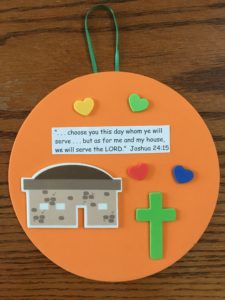Key Verse
“Thy way, O God, is in the sanctuary: who is so great a God as our God?” Psalm 77:13
Read the Key Verse with your class. Ask your students if they like to go to church. According to our memory verse, attending church is important to God. That is how we know the way to live a life pleasing to God. Help them understand the word sanctuary: a sacred place dedicated to the things of God. The church today is a place where we gather to focus upon the things of God and to learn of the things of God. There is no one (or any thing) greater to place our focus and attention upon than God, our God.
Summary Today we continue with the second of the Personal Books, Psalms. Remember that the Psalms is broken up into 5 books. We will look at book three of the Psalms (chapters 73-89) today, comparing them to the book of Leviticus. If you remember, the main theme of Leviticus was the tabernacle. That was the tent set up to hold the things of God and where man was to go to meet God.
When the tabernacle was completed, God spoke to Moses from the tabernacle instead of Mount Sinai. Once the people were free from the land of bondage, they needed to know how to live. There was great emphasis placed on the importance of being a sanctified people – set apart from the world and the things of the world. The people were to learn how to live as a people wholly given to God, in every aspect of their lives. Leviticus showed the ability to have fellowship with God when man came to Him as a sanctified people. (Because He is a Holy God and we are a sinful people.)
The first eleven Psalms of the third book of the Psalms were written by Asaph (he was one of the Levites David appointed to minister before the Ark of the Covenant with songs in I Chronicles 16:4-5.) We see him at one point as he struggled with jealousy over the prosperous wicked, until he went to the “sanctuary of God” – then he understood.
We also reemphasize the importance of learning from history (again), and what happens to those who forsake God. Through this book of the Psalms, we will learn the importance of God’s house, and the importance of serving Him. It ends with a praise encouraging us to make God’s faithfulness known to “all generations.”
Encourage your students to bring their Bibles and use them!
Emphasis: We are to learn the importance of not desiring the things of this world, but placing our focus (our heart’s desires) upon the things of God. The one place we can go to achieve this purpose, is the church (the sanctuary – that place dedicated to the things of God).
Optional Worksheets to be downloaded:
Lesson 43 – Volume 1 Children’s Worksheet 1
Lesson 43 – Volume 1 Children’s Reinforcement Worksheet
Ideas for children:
Stickers always work well with children. Often times I watch Wal-Mart or Oriental Trading Company for specials or deals on things I can use for crafts for Sunday School (i.e. foam sheets, Bible Story scene stickers, crowns, stick on jewels, construction paper, etc.). I keep a stash and when I need something, I go search in my stash! Pinterest always has great ideas!
You could have a coloring sheet that goes with the lesson.
One idea for today’s lesson: (See picture below). For today’s lesson I took a coloring of a church building. I cut out the windows and doors. The students were able to glue different colored pieces of small tissue paper to the back to make the windows look stained glass or just colorful. They then took time to color the church building. We are to encourage them to understand that the church building is a special place because it is the place God’s people go to meet together to place our attention on God and the things of God.
Mural idea:
Refer to the wall in your classroom that has become a mural.
By now your class should be in a groove as to the direction and areas in which they need to focus and work on to improve their Christian lives. Use this knowledge to help you address specific areas in each lesson that your class can discuss and share as you add new things to your mural. Continue to watch as your class grows in their knowledge of not only God’s Word, but areas in their lives that can be corrected, drawing them closer to the Lord.
Have them each add anything else they may have brought to add to the wall. Encourage everyone to participate.


